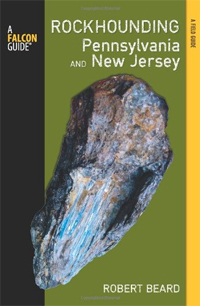By Robert Beard
 I recently purchased "Rockhounding Pennsylvania and New Jersey," By Robert Beard. This book describes many of the localities in these two states with the status and ability to collect there. Overall this is a great book, and is highly recommended. Although I am familiar with a lot of the locations described in the book, there were some that were new to me, and it also provided details on some of the localities that I was not aware of.
I recently purchased "Rockhounding Pennsylvania and New Jersey," By Robert Beard. This book describes many of the localities in these two states with the status and ability to collect there. Overall this is a great book, and is highly recommended. Although I am familiar with a lot of the locations described in the book, there were some that were new to me, and it also provided details on some of the localities that I was not aware of.
This book is an essential resource for any field collector in the area. I like the fact that the book lists a lot of localities, including non-collectible but import geological features to observe. There are good details on every locality, with very specific instructions on finding the locations. The book is well-organized in a very neat and clean format, and also provides good pictures of the localities described. It also says which locations are kid friendly, which I think is an extra step of usefulness.
The book describes both mineral and fossil localities. Though I am strictly a mineral collector, and the fossil localities are not as interesting to me, it is still nice to see these localities listed in the book for those who are interested in fossils. I don’t know why the author chose to describe New Jersey and Pennsylvania in one book. Granted these states are geographically next to each other, but they are quite different in many ways, including geologically and culturally. I would have separated this book into two books, one for each state, and provide a more extensive background on the geology and history of mining in each state.
I think that this book is a great resource for both expert collectors and novices alike. The experts can gain some additional localities and information that they would otherwise not have found, and the novices can gain a list of collectible localities which can be a learning experience for them. For the novices, more collecting information such as collecting behavior should have been included. Also, all the local clubs in each state should have been mentioned with contact information so that someone interested in this hobby can join a club for an additional level of enrichment in this hobby.
One of my biggest criticisms of the book is that it should not have provided the details on some of the classic locations that are meant only for the expert collectors. For example, I have heard that a classic locality mentioned in the book, which was well-known to local collectors, has now experienced an explosion of new visitors there, including out-of-area collectors. While the collecting status at this locality is definitely questionable and not publicly sanctioned, the owner has been tolerating an occasional collector here and there. But now with the location “discovered” and becoming quite busy, especially on weekends, it is doubtful that this status quo will remain. The last thing any serious collector wants is to have a classic locality closed down due to an excessive number of collectors or irresponsible rockhounds. One last criticism I have for the book is the cover photo, showing a nice kyanite from the Wissahickon formation in Pennsylvania. The picture itself is a good picture, but the outlines are clearly outlined and poorly shadowed with a Photoshop job.
Despite the above criticism, overall the author has done a great job, and I really enjoyed learning new things from this book. The author is planning on launching a book titled "Rockhounding in New York" this coming year as well, and I look forward to the new book when it comes out!
Click here to buy the book on Amazon.